Advanced Financial Accounting Assignment - University Name
VerifiedAdded on 2023/04/26
|8
|1306
|369
Homework Assignment
AI Summary
This document provides a comprehensive solution to an advanced financial accounting assignment. The solution addresses several key areas, including the calculation of current tax and the preparation of the tax journal entry, with detailed explanations of the steps involved. It also analyzes a call option contract, categorizing it as a derivative financial instrument and outlining the accounting treatment from both the buyer's and seller's perspectives, including journal entries. Furthermore, the document includes journal entries for various transactions, such as purchases and land acquisition, and provides a detailed analysis of consolidated financial statements, covering the acquisition of a subsidiary, calculation of goodwill, and preparation of consolidated profit and loss statements and balance sheets. The assignment covers topics such as derivative instruments, journal entries, and consolidated financial statements.
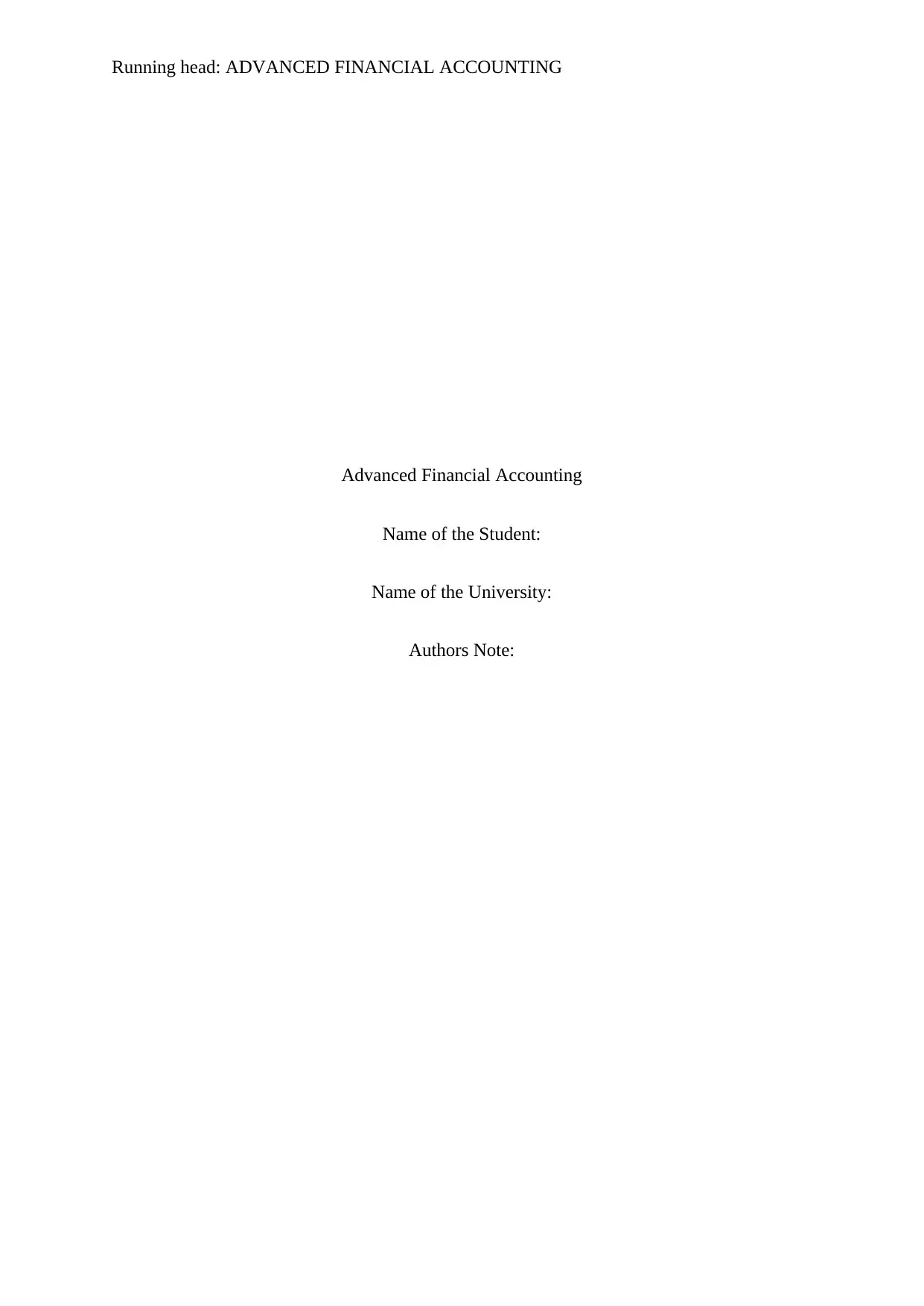
Running head: ADVANCED FINANCIAL ACCOUNTING
Advanced Financial Accounting
Name of the Student:
Name of the University:
Authors Note:
Advanced Financial Accounting
Name of the Student:
Name of the University:
Authors Note:
Paraphrase This Document
Need a fresh take? Get an instant paraphrase of this document with our AI Paraphraser
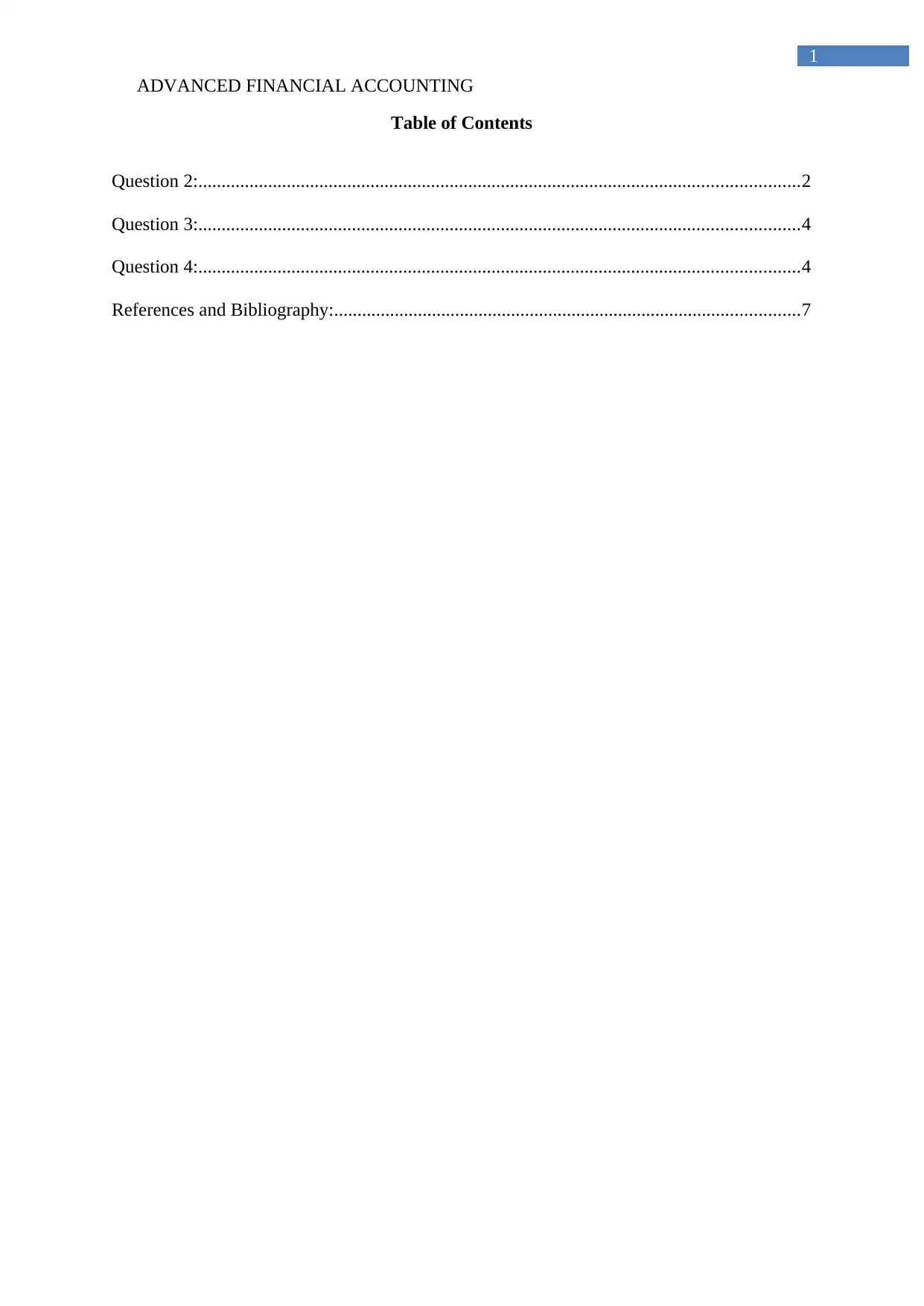
ADVANCED FINANCIAL ACCOUNTING
1
Table of Contents
Question 2:.................................................................................................................................2
Question 3:.................................................................................................................................4
Question 4:.................................................................................................................................4
References and Bibliography:....................................................................................................7
1
Table of Contents
Question 2:.................................................................................................................................2
Question 3:.................................................................................................................................4
Question 4:.................................................................................................................................4
References and Bibliography:....................................................................................................7
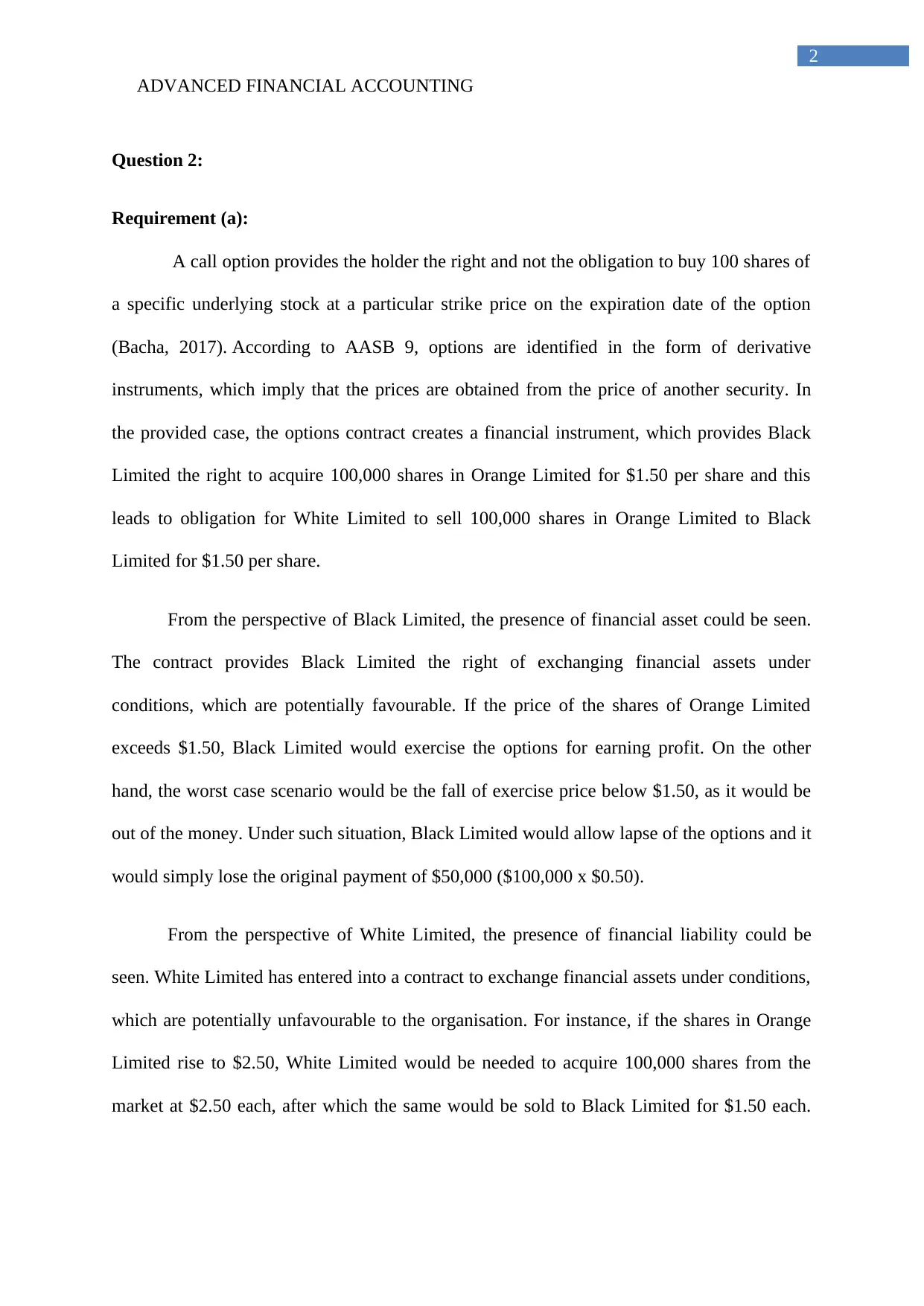
ADVANCED FINANCIAL ACCOUNTING
2
Question 2:
Requirement (a):
A call option provides the holder the right and not the obligation to buy 100 shares of
a specific underlying stock at a particular strike price on the expiration date of the option
(Bacha, 2017). According to AASB 9, options are identified in the form of derivative
instruments, which imply that the prices are obtained from the price of another security. In
the provided case, the options contract creates a financial instrument, which provides Black
Limited the right to acquire 100,000 shares in Orange Limited for $1.50 per share and this
leads to obligation for White Limited to sell 100,000 shares in Orange Limited to Black
Limited for $1.50 per share.
From the perspective of Black Limited, the presence of financial asset could be seen.
The contract provides Black Limited the right of exchanging financial assets under
conditions, which are potentially favourable. If the price of the shares of Orange Limited
exceeds $1.50, Black Limited would exercise the options for earning profit. On the other
hand, the worst case scenario would be the fall of exercise price below $1.50, as it would be
out of the money. Under such situation, Black Limited would allow lapse of the options and it
would simply lose the original payment of $50,000 ($100,000 x $0.50).
From the perspective of White Limited, the presence of financial liability could be
seen. White Limited has entered into a contract to exchange financial assets under conditions,
which are potentially unfavourable to the organisation. For instance, if the shares in Orange
Limited rise to $2.50, White Limited would be needed to acquire 100,000 shares from the
market at $2.50 each, after which the same would be sold to Black Limited for $1.50 each.
2
Question 2:
Requirement (a):
A call option provides the holder the right and not the obligation to buy 100 shares of
a specific underlying stock at a particular strike price on the expiration date of the option
(Bacha, 2017). According to AASB 9, options are identified in the form of derivative
instruments, which imply that the prices are obtained from the price of another security. In
the provided case, the options contract creates a financial instrument, which provides Black
Limited the right to acquire 100,000 shares in Orange Limited for $1.50 per share and this
leads to obligation for White Limited to sell 100,000 shares in Orange Limited to Black
Limited for $1.50 per share.
From the perspective of Black Limited, the presence of financial asset could be seen.
The contract provides Black Limited the right of exchanging financial assets under
conditions, which are potentially favourable. If the price of the shares of Orange Limited
exceeds $1.50, Black Limited would exercise the options for earning profit. On the other
hand, the worst case scenario would be the fall of exercise price below $1.50, as it would be
out of the money. Under such situation, Black Limited would allow lapse of the options and it
would simply lose the original payment of $50,000 ($100,000 x $0.50).
From the perspective of White Limited, the presence of financial liability could be
seen. White Limited has entered into a contract to exchange financial assets under conditions,
which are potentially unfavourable to the organisation. For instance, if the shares in Orange
Limited rise to $2.50, White Limited would be needed to acquire 100,000 shares from the
market at $2.50 each, after which the same would be sold to Black Limited for $1.50 each.
⊘ This is a preview!⊘
Do you want full access?
Subscribe today to unlock all pages.

Trusted by 1+ million students worldwide
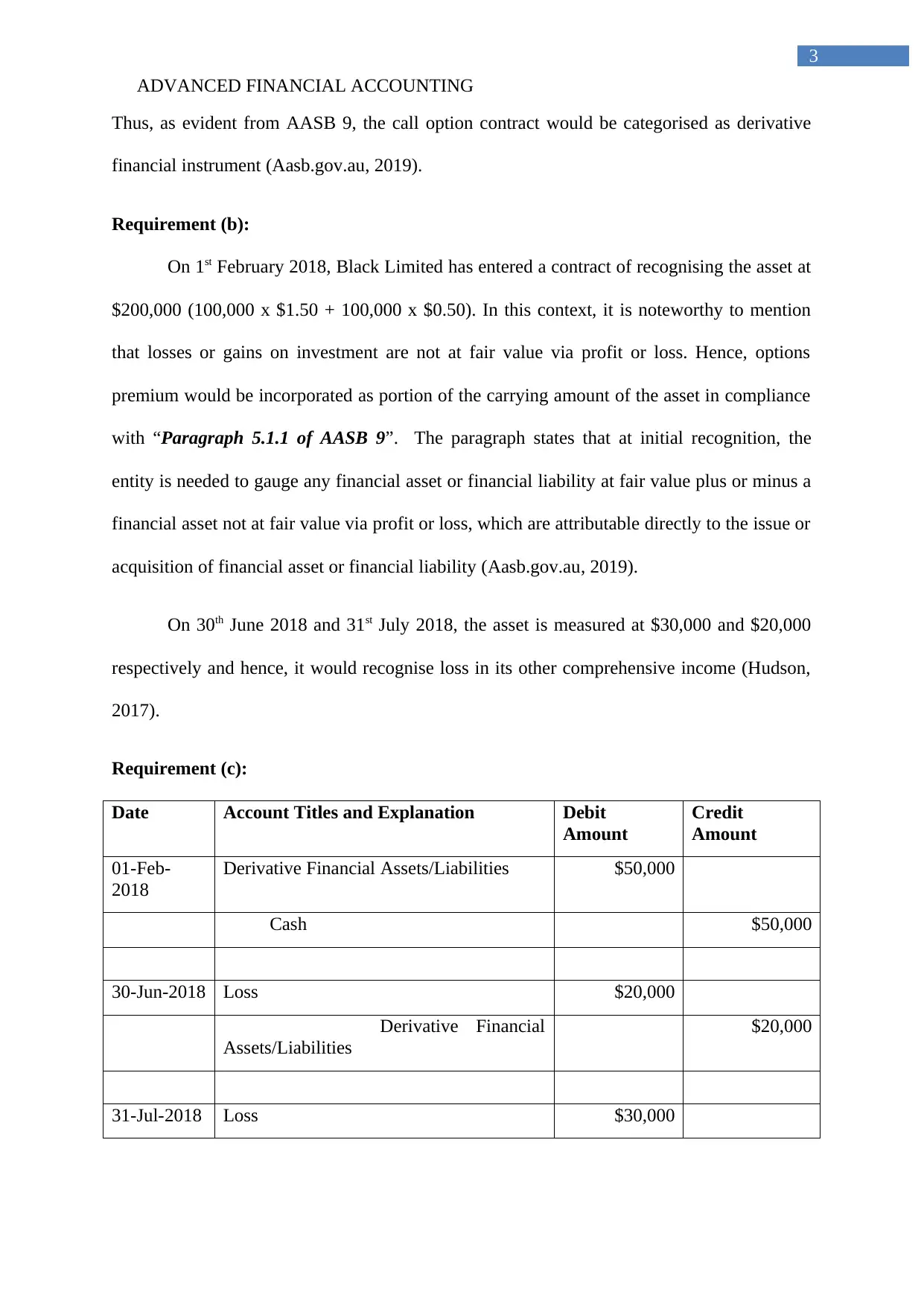
ADVANCED FINANCIAL ACCOUNTING
3
Thus, as evident from AASB 9, the call option contract would be categorised as derivative
financial instrument (Aasb.gov.au, 2019).
Requirement (b):
On 1st February 2018, Black Limited has entered a contract of recognising the asset at
$200,000 (100,000 x $1.50 + 100,000 x $0.50). In this context, it is noteworthy to mention
that losses or gains on investment are not at fair value via profit or loss. Hence, options
premium would be incorporated as portion of the carrying amount of the asset in compliance
with “Paragraph 5.1.1 of AASB 9”. The paragraph states that at initial recognition, the
entity is needed to gauge any financial asset or financial liability at fair value plus or minus a
financial asset not at fair value via profit or loss, which are attributable directly to the issue or
acquisition of financial asset or financial liability (Aasb.gov.au, 2019).
On 30th June 2018 and 31st July 2018, the asset is measured at $30,000 and $20,000
respectively and hence, it would recognise loss in its other comprehensive income (Hudson,
2017).
Requirement (c):
Date Account Titles and Explanation Debit
Amount
Credit
Amount
01-Feb-
2018
Derivative Financial Assets/Liabilities $50,000
Cash $50,000
30-Jun-2018 Loss $20,000
Derivative Financial
Assets/Liabilities
$20,000
31-Jul-2018 Loss $30,000
3
Thus, as evident from AASB 9, the call option contract would be categorised as derivative
financial instrument (Aasb.gov.au, 2019).
Requirement (b):
On 1st February 2018, Black Limited has entered a contract of recognising the asset at
$200,000 (100,000 x $1.50 + 100,000 x $0.50). In this context, it is noteworthy to mention
that losses or gains on investment are not at fair value via profit or loss. Hence, options
premium would be incorporated as portion of the carrying amount of the asset in compliance
with “Paragraph 5.1.1 of AASB 9”. The paragraph states that at initial recognition, the
entity is needed to gauge any financial asset or financial liability at fair value plus or minus a
financial asset not at fair value via profit or loss, which are attributable directly to the issue or
acquisition of financial asset or financial liability (Aasb.gov.au, 2019).
On 30th June 2018 and 31st July 2018, the asset is measured at $30,000 and $20,000
respectively and hence, it would recognise loss in its other comprehensive income (Hudson,
2017).
Requirement (c):
Date Account Titles and Explanation Debit
Amount
Credit
Amount
01-Feb-
2018
Derivative Financial Assets/Liabilities $50,000
Cash $50,000
30-Jun-2018 Loss $20,000
Derivative Financial
Assets/Liabilities
$20,000
31-Jul-2018 Loss $30,000
Paraphrase This Document
Need a fresh take? Get an instant paraphrase of this document with our AI Paraphraser
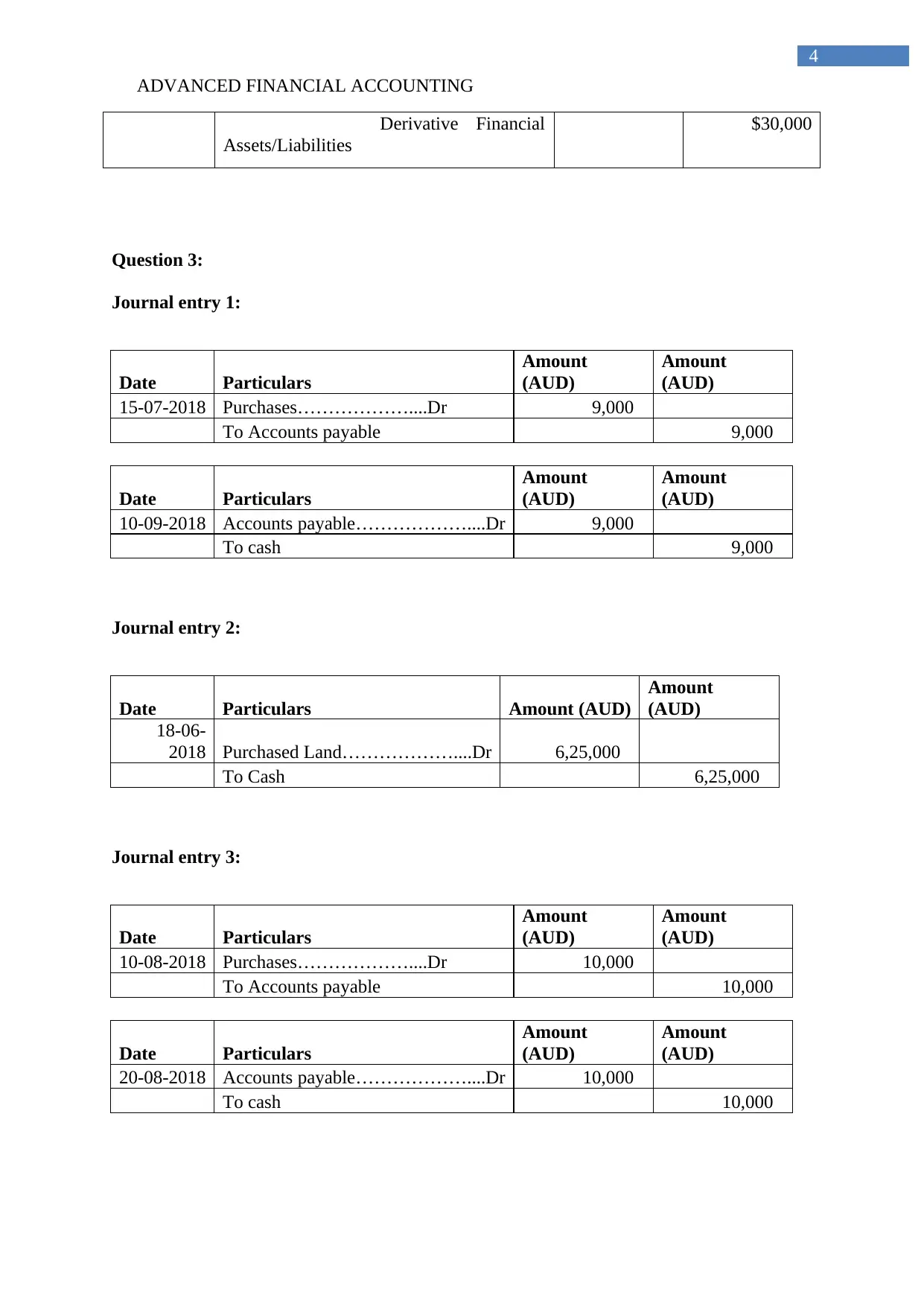
ADVANCED FINANCIAL ACCOUNTING
4
Derivative Financial
Assets/Liabilities
$30,000
Question 3:
Journal entry 1:
Date Particulars
Amount
(AUD)
Amount
(AUD)
15-07-2018 Purchases………………....Dr 9,000
To Accounts payable 9,000
Date Particulars
Amount
(AUD)
Amount
(AUD)
10-09-2018 Accounts payable………………....Dr 9,000
To cash 9,000
Journal entry 2:
Date Particulars Amount (AUD)
Amount
(AUD)
18-06-
2018 Purchased Land………………....Dr 6,25,000
To Cash 6,25,000
Journal entry 3:
Date Particulars
Amount
(AUD)
Amount
(AUD)
10-08-2018 Purchases………………....Dr 10,000
To Accounts payable 10,000
Date Particulars
Amount
(AUD)
Amount
(AUD)
20-08-2018 Accounts payable………………....Dr 10,000
To cash 10,000
4
Derivative Financial
Assets/Liabilities
$30,000
Question 3:
Journal entry 1:
Date Particulars
Amount
(AUD)
Amount
(AUD)
15-07-2018 Purchases………………....Dr 9,000
To Accounts payable 9,000
Date Particulars
Amount
(AUD)
Amount
(AUD)
10-09-2018 Accounts payable………………....Dr 9,000
To cash 9,000
Journal entry 2:
Date Particulars Amount (AUD)
Amount
(AUD)
18-06-
2018 Purchased Land………………....Dr 6,25,000
To Cash 6,25,000
Journal entry 3:
Date Particulars
Amount
(AUD)
Amount
(AUD)
10-08-2018 Purchases………………....Dr 10,000
To Accounts payable 10,000
Date Particulars
Amount
(AUD)
Amount
(AUD)
20-08-2018 Accounts payable………………....Dr 10,000
To cash 10,000
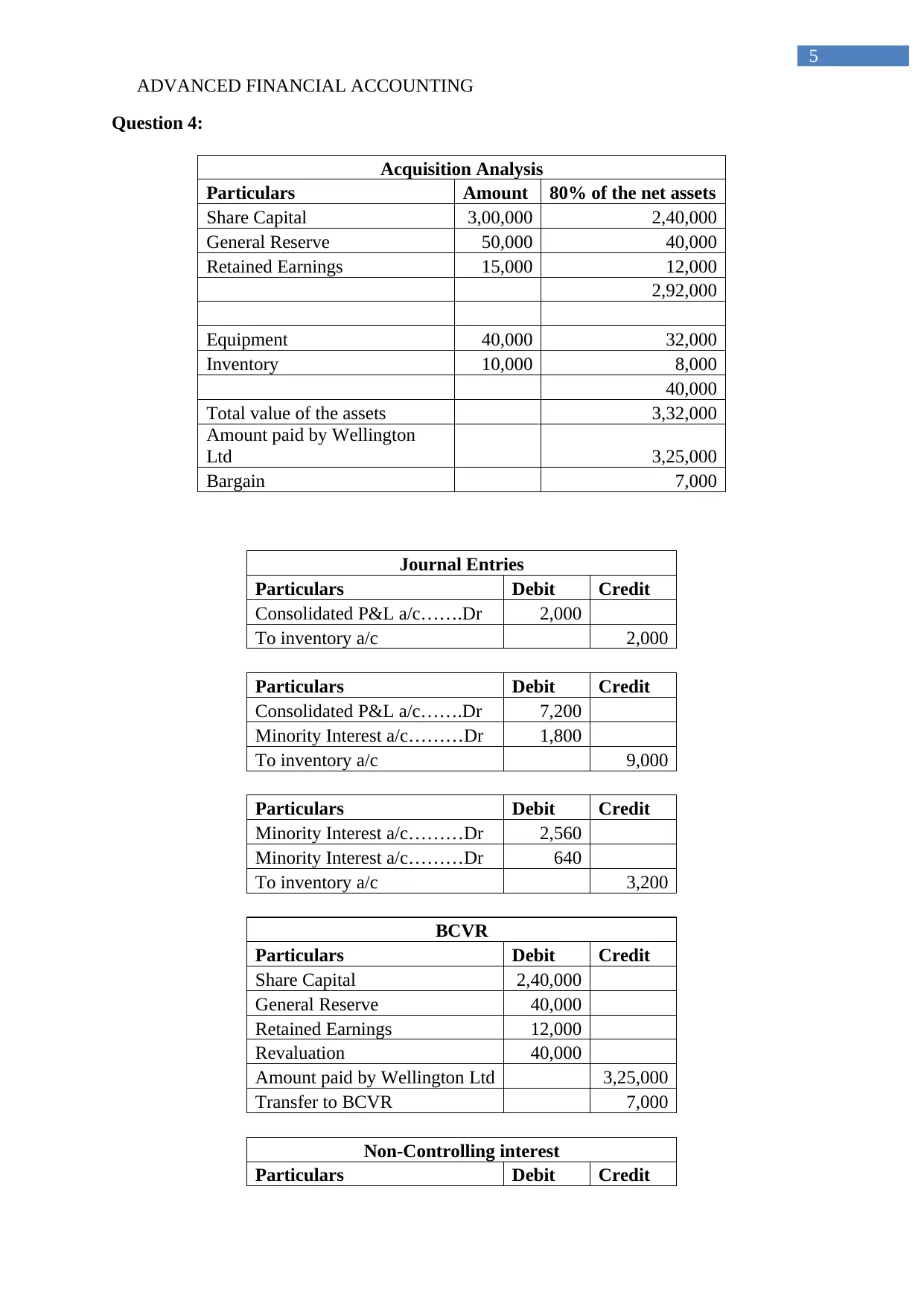
ADVANCED FINANCIAL ACCOUNTING
5
Question 4:
Acquisition Analysis
Particulars Amount 80% of the net assets
Share Capital 3,00,000 2,40,000
General Reserve 50,000 40,000
Retained Earnings 15,000 12,000
2,92,000
Equipment 40,000 32,000
Inventory 10,000 8,000
40,000
Total value of the assets 3,32,000
Amount paid by Wellington
Ltd 3,25,000
Bargain 7,000
Journal Entries
Particulars Debit Credit
Consolidated P&L a/c…….Dr 2,000
To inventory a/c 2,000
Particulars Debit Credit
Consolidated P&L a/c…….Dr 7,200
Minority Interest a/c………Dr 1,800
To inventory a/c 9,000
Particulars Debit Credit
Minority Interest a/c………Dr 2,560
Minority Interest a/c………Dr 640
To inventory a/c 3,200
BCVR
Particulars Debit Credit
Share Capital 2,40,000
General Reserve 40,000
Retained Earnings 12,000
Revaluation 40,000
Amount paid by Wellington Ltd 3,25,000
Transfer to BCVR 7,000
Non-Controlling interest
Particulars Debit Credit
5
Question 4:
Acquisition Analysis
Particulars Amount 80% of the net assets
Share Capital 3,00,000 2,40,000
General Reserve 50,000 40,000
Retained Earnings 15,000 12,000
2,92,000
Equipment 40,000 32,000
Inventory 10,000 8,000
40,000
Total value of the assets 3,32,000
Amount paid by Wellington
Ltd 3,25,000
Bargain 7,000
Journal Entries
Particulars Debit Credit
Consolidated P&L a/c…….Dr 2,000
To inventory a/c 2,000
Particulars Debit Credit
Consolidated P&L a/c…….Dr 7,200
Minority Interest a/c………Dr 1,800
To inventory a/c 9,000
Particulars Debit Credit
Minority Interest a/c………Dr 2,560
Minority Interest a/c………Dr 640
To inventory a/c 3,200
BCVR
Particulars Debit Credit
Share Capital 2,40,000
General Reserve 40,000
Retained Earnings 12,000
Revaluation 40,000
Amount paid by Wellington Ltd 3,25,000
Transfer to BCVR 7,000
Non-Controlling interest
Particulars Debit Credit
⊘ This is a preview!⊘
Do you want full access?
Subscribe today to unlock all pages.

Trusted by 1+ million students worldwide
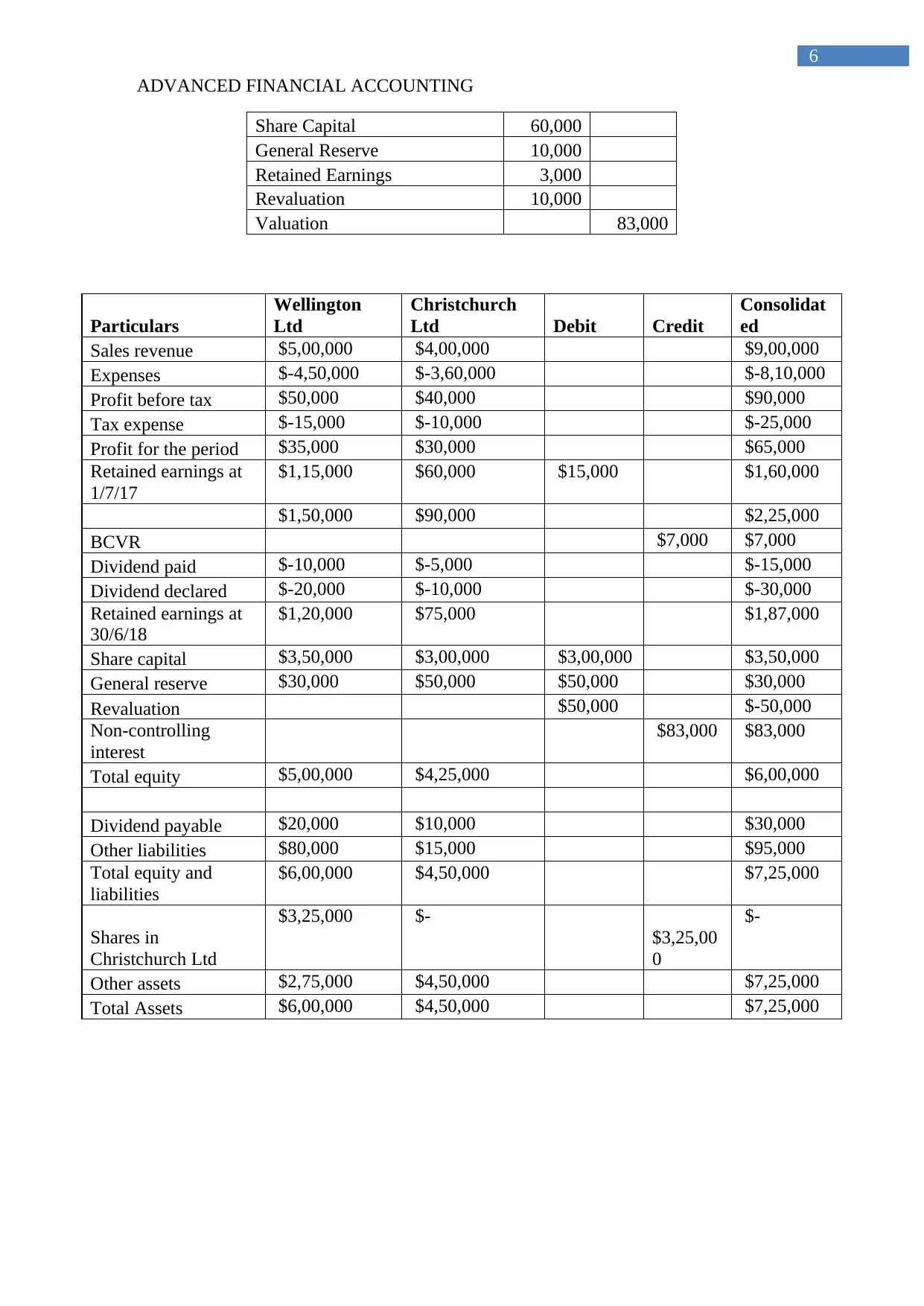
ADVANCED FINANCIAL ACCOUNTING
6
Share Capital 60,000
General Reserve 10,000
Retained Earnings 3,000
Revaluation 10,000
Valuation 83,000
Particulars
Wellington
Ltd
Christchurch
Ltd Debit Credit
Consolidat
ed
Sales revenue $5,00,000 $4,00,000 $9,00,000
Expenses $-4,50,000 $-3,60,000 $-8,10,000
Profit before tax $50,000 $40,000 $90,000
Tax expense $-15,000 $-10,000 $-25,000
Profit for the period $35,000 $30,000 $65,000
Retained earnings at
1/7/17
$1,15,000 $60,000 $15,000 $1,60,000
$1,50,000 $90,000 $2,25,000
BCVR $7,000 $7,000
Dividend paid $-10,000 $-5,000 $-15,000
Dividend declared $-20,000 $-10,000 $-30,000
Retained earnings at
30/6/18
$1,20,000 $75,000 $1,87,000
Share capital $3,50,000 $3,00,000 $3,00,000 $3,50,000
General reserve $30,000 $50,000 $50,000 $30,000
Revaluation $50,000 $-50,000
Non-controlling
interest
$83,000 $83,000
Total equity $5,00,000 $4,25,000 $6,00,000
Dividend payable $20,000 $10,000 $30,000
Other liabilities $80,000 $15,000 $95,000
Total equity and
liabilities
$6,00,000 $4,50,000 $7,25,000
Shares in
Christchurch Ltd
$3,25,000 $-
$3,25,00
0
$-
Other assets $2,75,000 $4,50,000 $7,25,000
Total Assets $6,00,000 $4,50,000 $7,25,000
6
Share Capital 60,000
General Reserve 10,000
Retained Earnings 3,000
Revaluation 10,000
Valuation 83,000
Particulars
Wellington
Ltd
Christchurch
Ltd Debit Credit
Consolidat
ed
Sales revenue $5,00,000 $4,00,000 $9,00,000
Expenses $-4,50,000 $-3,60,000 $-8,10,000
Profit before tax $50,000 $40,000 $90,000
Tax expense $-15,000 $-10,000 $-25,000
Profit for the period $35,000 $30,000 $65,000
Retained earnings at
1/7/17
$1,15,000 $60,000 $15,000 $1,60,000
$1,50,000 $90,000 $2,25,000
BCVR $7,000 $7,000
Dividend paid $-10,000 $-5,000 $-15,000
Dividend declared $-20,000 $-10,000 $-30,000
Retained earnings at
30/6/18
$1,20,000 $75,000 $1,87,000
Share capital $3,50,000 $3,00,000 $3,00,000 $3,50,000
General reserve $30,000 $50,000 $50,000 $30,000
Revaluation $50,000 $-50,000
Non-controlling
interest
$83,000 $83,000
Total equity $5,00,000 $4,25,000 $6,00,000
Dividend payable $20,000 $10,000 $30,000
Other liabilities $80,000 $15,000 $95,000
Total equity and
liabilities
$6,00,000 $4,50,000 $7,25,000
Shares in
Christchurch Ltd
$3,25,000 $-
$3,25,00
0
$-
Other assets $2,75,000 $4,50,000 $7,25,000
Total Assets $6,00,000 $4,50,000 $7,25,000
Paraphrase This Document
Need a fresh take? Get an instant paraphrase of this document with our AI Paraphraser
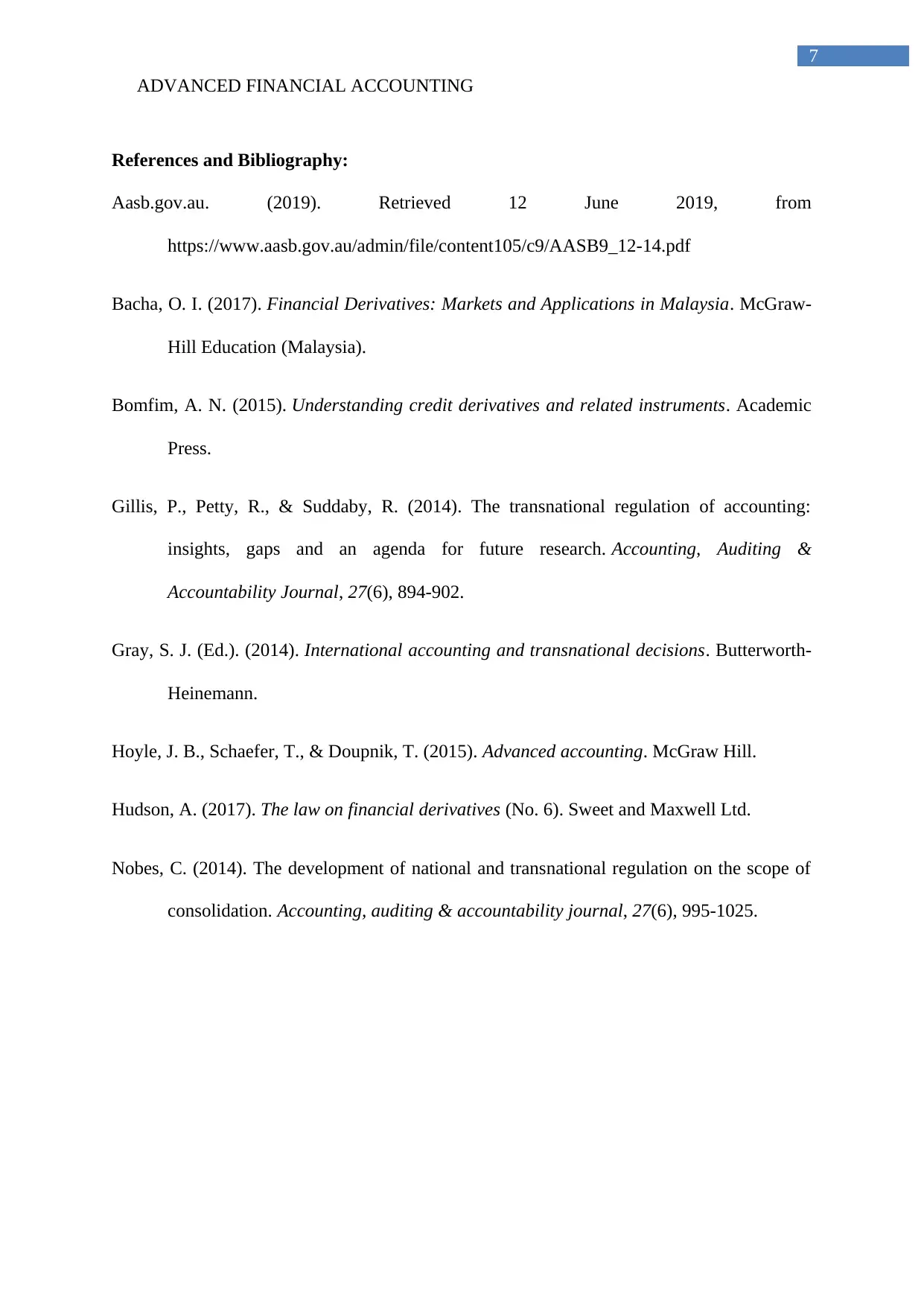
ADVANCED FINANCIAL ACCOUNTING
7
References and Bibliography:
Aasb.gov.au. (2019). Retrieved 12 June 2019, from
https://www.aasb.gov.au/admin/file/content105/c9/AASB9_12-14.pdf
Bacha, O. I. (2017). Financial Derivatives: Markets and Applications in Malaysia. McGraw-
Hill Education (Malaysia).
Bomfim, A. N. (2015). Understanding credit derivatives and related instruments. Academic
Press.
Gillis, P., Petty, R., & Suddaby, R. (2014). The transnational regulation of accounting:
insights, gaps and an agenda for future research. Accounting, Auditing &
Accountability Journal, 27(6), 894-902.
Gray, S. J. (Ed.). (2014). International accounting and transnational decisions. Butterworth-
Heinemann.
Hoyle, J. B., Schaefer, T., & Doupnik, T. (2015). Advanced accounting. McGraw Hill.
Hudson, A. (2017). The law on financial derivatives (No. 6). Sweet and Maxwell Ltd.
Nobes, C. (2014). The development of national and transnational regulation on the scope of
consolidation. Accounting, auditing & accountability journal, 27(6), 995-1025.
7
References and Bibliography:
Aasb.gov.au. (2019). Retrieved 12 June 2019, from
https://www.aasb.gov.au/admin/file/content105/c9/AASB9_12-14.pdf
Bacha, O. I. (2017). Financial Derivatives: Markets and Applications in Malaysia. McGraw-
Hill Education (Malaysia).
Bomfim, A. N. (2015). Understanding credit derivatives and related instruments. Academic
Press.
Gillis, P., Petty, R., & Suddaby, R. (2014). The transnational regulation of accounting:
insights, gaps and an agenda for future research. Accounting, Auditing &
Accountability Journal, 27(6), 894-902.
Gray, S. J. (Ed.). (2014). International accounting and transnational decisions. Butterworth-
Heinemann.
Hoyle, J. B., Schaefer, T., & Doupnik, T. (2015). Advanced accounting. McGraw Hill.
Hudson, A. (2017). The law on financial derivatives (No. 6). Sweet and Maxwell Ltd.
Nobes, C. (2014). The development of national and transnational regulation on the scope of
consolidation. Accounting, auditing & accountability journal, 27(6), 995-1025.
1 out of 8
Related Documents
Your All-in-One AI-Powered Toolkit for Academic Success.
+13062052269
info@desklib.com
Available 24*7 on WhatsApp / Email
![[object Object]](/_next/static/media/star-bottom.7253800d.svg)
Unlock your academic potential
Copyright © 2020–2025 A2Z Services. All Rights Reserved. Developed and managed by ZUCOL.





